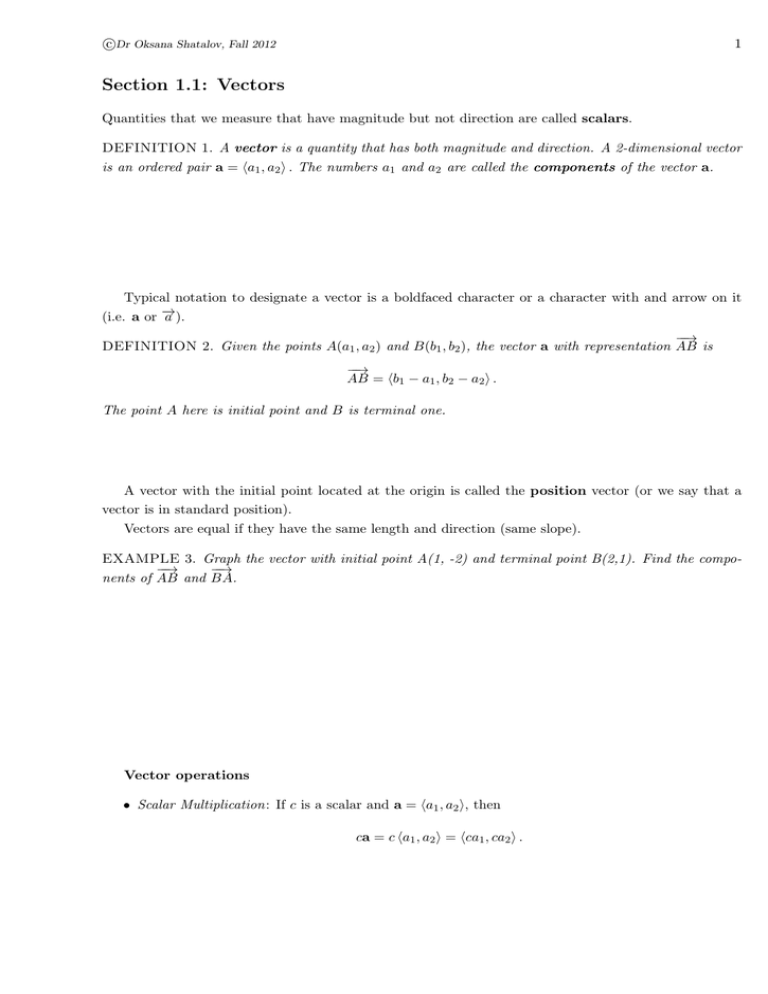Document 10581520
advertisement

c Dr Oksana Shatalov, Fall 2012 1 Section 1.1: Vectors Quantities that we measure that have magnitude but not direction are called scalars. DEFINITION 1. A vector is a quantity that has both magnitude and direction. A 2-dimensional vector is an ordered pair a = ha1 , a2 i . The numbers a1 and a2 are called the components of the vector a. Typical notation to designate a vector is a boldfaced character or a character with and arrow on it − (i.e. a or → a ). −−→ DEFINITION 2. Given the points A(a1 , a2 ) and B(b1 , b2 ), the vector a with representation AB is −−→ AB = hb1 − a1 , b2 − a2 i . The point A here is initial point and B is terminal one. A vector with the initial point located at the origin is called the position vector (or we say that a vector is in standard position). Vectors are equal if they have the same length and direction (same slope). EXAMPLE 3. Graph the vector with initial point A(1, -2) and terminal point B(2,1). Find the compo−−→ −−→ nents of AB and BA. Vector operations • Scalar Multiplication: If c is a scalar and a = ha1 , a2 i, then ca = c ha1 , a2 i = hca1 , ca2 i . c Dr Oksana Shatalov, Fall 2012 2 DEFINITION 4. Two vectors a and b are called parallel if b = ca with some scalar c. If c > 0 then a and ca have the same direction, if c < 0 then a and ca have the opposite direction. • Vector addition: If a = ha1 , a2 i and b = hb1 , b2 i then a + b = ha1 + b1 , a2 + b2 i . Triangle Law Parallelogram Law a + b is called the resultant vector EXAMPLE 5. Let a = h−1, 2i and b = h2.1, −0.5i. Then 3a + 2b = The magnitude or length of a vector a = ha1 , a2 i is denoted by |a|, |a| = D √ √ E EXAMPLE 6. Find: |h3, −8i| , 22 , 22 , |0| c Dr Oksana Shatalov, Fall 2012 3 A unit vector is a vector with length one. Any vector can be made into a unit vector by dividing it by its length. So, a unit vector in the direction of a is u= a . |a| Any vector a can be fully represented by providing its length, |a| and a unit vector u in its direction: a = |a| u EXAMPLE 7. Given a = h2, −1i. Find (a) a unit vector that has the same direction as a; (b) a vector b in the direction opposite to a s.t |b| = 7. The standard basis vectors are given by the unit vectors i = h1, 0i and j = h0, 1i along the x and y directions, respectively. Using the basis vectors, one can represent any vector a = ha1 , a2 i as a = a1 i + a2 j. EXAMPLE 8. Given a = 2i − j, b = h5, −2i. Find a scalars s and t such that sa + tb = −4j. c Dr Oksana Shatalov, Fall 2012 4 Applications: Quantities such as force, displacement or velocity that have direction as well as magnitude are represented by vectors. EXAMPLE 9. Ben walks due west on the deck of a ship at 5 mph. The ship is moving north at a speed of 25 mph. Find the direction and speed of Ben relative to the surface of the water. c Dr Oksana Shatalov, Fall 2012 5 EXAMPLE 10. Two forces F1 and F2 with magnitudes 14 pounds and 12 pounds act on an object at a point P as shown. Find the resultant force as well as it’s magnitude and direction. c Dr Oksana Shatalov, Fall 2012 6 EXAMPLE 11. An 60 pound weight hangs from two wires as shown. Find the tensions (forces) in both wires and their magnitudes. c Dr Oksana Shatalov, Fall 2012 7 EXAMPLE 12. An airplane, flying due east at an airspeed of 450mph, encounters a 50-mph wind acting in the direction of E60o N (60o North of East). The airplane holds its compass heading due east but, because of the wind, acquires a new ground speed (i.e. the magnitude of the resultant) and direction. What are they?


